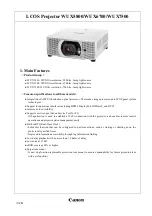
GLOSSARY
A-4
DLV 1280 User's Manual
A list of selectable options displayed on the screen.
A video output format of some video tape and disk players. There are two types
of NTSC (National Television Standards Committee) video: NTSC 3.58 and
NTSC 4.43. NTSC 3.58 is used primarily in North America and Japan.
NTSC 4.43 is less commonly used.
A type of rear-projection screen which re-directs light through the screen to
increase image brightness in front of the screen. Screen gain is usually greater
than 1 but audience viewing angles are reduced.
PAL (Phase Alternating Line) video is a 50 Hz standard with 768 x 576
resolution. It is found on some video tape and disk players (used primarily in
Europe, China and some South American and African countries).
A distortion of the image possible on some types of projectors, characterized by
concave or convex borders.
The smallest discernible element of data from a computer-generated image.
The phase of the pixel sampling clock relative to incoming data.
The frequency of the pixel sampling clock, indicated by the number of pixels per
line.
The projector is at presentation level when an image from a source is displayed
without the presence of a slidebar, menu, pull-down list, or error message. For
example, if a help page is displayed, the projector is not at presentation level.
The distance between the projector's front feet and the screen. Also called
"Throw Distance”.
The type of code format utilized by remote keypad(s). For any keypad, the
default protocol from manufacture is Protocol A. By using two different
protocols, two projectors may be used side by side while being controlled
independently by their remote IR keypads.
A selectable menu item that unfolds into a list of options pertaining to a given
parameter.
A translucent panel for screen projection. Incident light travels through the
incident surface of a rear screen and forms an image on the other surface.
The maximum number of alternate white and black horizontal lines that can be
distinguished on a screen when a photographic target placed between the lens
and a light source is illuminated by that light source.
The maximum number of pixels that the projector can display horizontally and
vertically across an image. In DLV 1280, resolution is 1280 x 1024.
The minimum time required for a CRT projector to move the position of the
scanning spot from the right edge to the left edge.
Menu
'
NTSC Video
'
Optical Screen
'
PAL Video
'
Pincushion
'
Pixel (picture element)
'
Pixel Phase
'
Pixel Tracking
'
Presentation Level
'
Projector-to-Screen
'
Distance
Protocol
'
Pull-down List
'
Rear Screen
'
Resolution (lens)
'
Resolution (projector)
'
Retrace Time
'
(Horizontal)















































